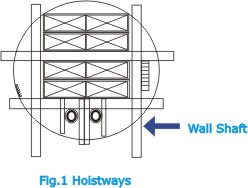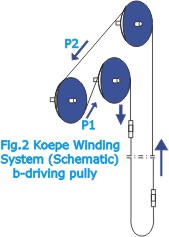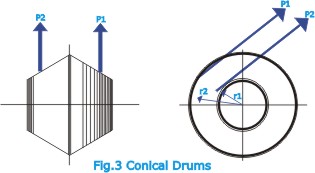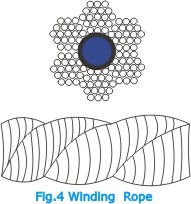Winding |
|
| The
term winding refers to the operation associated with hoisting
the mined mineral to the surface. In modern mines winding
is automated i.e. controlled by electrical contacts in conjunction
with acoustic and visual signaling and various devices to
ensure safety when men are being raised or lowered. All winding
systems embody the counterweight principle, with two cages
(or skips) moving in opposite directions one ascending while
the other descends.
|
|
|
The
basic characteristic of the winding gear are the winding engine
or motor, the headframe usually a lattice steel structure,
up to 200 ft. high, over the shaft, the winding rope and drum,
the cages or the skips, the intermediate gear whereby the
latter are connected to the rope, and cage guides in the shaft.
|
|
 |
|
| Large-diameter
shafts of circular section up to 7 m (23 ft.) diameter –are
normally equipped with two sets of winding gear; there are
thus four hoistways (Fig.1), in each of which a cage moves
up and down. Steam-powered winding engines or electric winders
are employed, the latter usually being driven by direct-current
electric motors with Ward-Leonard control. Such motors may
have power ratings of as high as 12,000 KW and hoist coal
or other minerals at a rate of 10,000 tons per day from shafts
800 m (2600 ft) in depth. The hoisting speed in deep shafts
is about 22m/sec. (70-75 ft/sec.) with a 30-ton payload.
|
|
 |
|
| The
winding operations are controlled by a device known as winding-speed
regulator. It calculates the hoisting speed in relation to
the distance traveled and more particularly limits the acceleration
of ascent and descent. In addition, every winding system includes
a depth indicator, which consists essentially of a screw spindle
along which a nut travels; the position of the nut on the
spindle indicates the position of the cage in the shaft. |
|
| This
device is linked to an overwind-prevention device, which actuates
a second brake (drop-weight brake) if the cage ascends too
high and the counter-balancing cage consequently descends
too low. In the event of overwinding, the cage is slowed down
and braked by such means as thickening the cage-guide rods
in the top part of the headframe. |
|
 |
|
| Winding
ropes are composed of several strands which in turn consist
of cold-drawn steel wires of 2.5mm (0.1 in.) diameter, with
a tensile strength of 200 kg/mm2 (127 tons/in2)(Fig.4). Such
ropes may be as much as 100mm (4 in) thick and have breaking
loads of around 700 tons.
|
|
 |
|
| |
|
| In
Britain, cage winding is still predominant in coal mining.
However, skip winding is progressively being introduced; it
is already extensively used in the United States and in various
continental countries. A skip is a guided steel or aluminum-alloy
box (Fig.5) which is automatically filled at the bottom of
the shaft and automatically discharged when it has been hoisted
aboveground. |
|
| The
advantage of skip winding is that a skip can carry a relatively
larger payload than a cage with tubs or cars; the proportion
of payload to total load can be raised by nearly 40% by substituting
skip for cage winding, and loading and unloading are faster.
In the main, there are two systems of winding gear: drum winding
and Koepe winding. |
|
Of these,
drum winding is the more widely applied. The drum may be variously
shaped: cylindrical, conical, cylindroconical. The object
of the conical shape (Fig.3) is to equalize the driving torque
by using a smaller diameter of drum when exerting maximum
rope pull to lift and accelerate the cage (or skip). In Germany
and Holland the Koepe system (Fig.2) is generally preferred.
In this system the massive drum is replaced by a wheel with
one peripheral groove.
|
|
A single
winding rope lies in this groove, and all controlling forces
transmitted through the rope depend on the friction of the
rope in the groove. The cages (or skips) are suspended one
on each end of the rope, which passes over the Koepe wheel.
The system offers certain advantages and is more particularly
suitable for winding heavy loads from deep levels. |
|
|
o
DISCLAIMER o
CONTACT US |